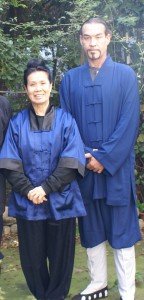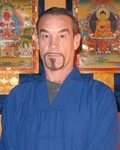[East West Perspective 东西方之观点]
The Virtue of Patient Care
by Gary Greer
Technological advances in health care has led to a common belief that physicians tend to detach themselves from their patients.[i] As a result, a paradigm shift from disease care to “Patient-Centered Care” has emerged, where clinicians and health care systems are turning their focus back to the patient.[ii] I believe that maintaining patient-centered care is essential in schools of Traditional Chinese medicine (TCM). Rather than maintaining its Eastern philosophical roots, TCM has been conforming to a Western clinical model that places the patient in the peripheral rather than the center. Such conformity has made the “tradition” in TCM a misnomer, for TCM as taught and clinically practiced today is nearly devoid of its traditional foundation, the ancient philosophy of Daoism.[iii] 
When I was a budding student comparing the multitude of acupuncture and oriental medicine schools offered in the United States, I recognized that the curriculum in a majority of the schools required countless hours of clinical competencies and biomedicine. Yet, I was puzzled that few schools did not offer courses, much less required, a study of Daoism. At the acupuncture school where I currently teach Daoist Medicine and Qi Gong, all of the 3rd and 4th-year transfer students of TCM lacked knowledge of the foundational relationship between acupuncture and Daoism. I once asked my teacher, Heavenly Master Zhang Yi Xiang, for specifics on how she was able to help so many people at her acupuncture clinic. She emphasized to me her belief that one is not truly successful unless one practices the virtues of compassion and selflessness. Master Zhang stressed that virtuous qi heals beyond the physical.
To cultivate virtue, one must connect to the root of TCM, the Daodejing. Virtue and following the way of nature resonates in the very essence of Daoist health, healing, and longevity. In Chapter 7 of the Daodejing, Laozi wrote about “Sheathing the light 韜光”:
天長地久Heaven and Earth are everlasting
天地所以能長而久者The reason Heaven and Earth can last forever
以其不自生Is that they do not exist for themselves
故以長久Thus they can last forever
是以聖人Therefore the sages:
後其身,而身先Place themselves last but end up in front
外其身,而身存Are outside of themselves and yet survive
非以其無私邪?Is it not due to their selflessness?
故能成其私That is how they can achieve their own goals
Practitioners of TCM should learn and develop this virtuous light. It is through the observation of nature that Laozi exemplified his lessons. Heaven provides all living beings with water and nourishes everything. The earth provides all the food and shelter needed, and the various herbs provide healing for our selves and our patients. All is provided with no expectation of return.
 Chapter 67 of Laozi’s Daodejing offered three treasures of Daoism三寶to facilitate the practice of virtue. The first treasure is compassion 慈. There is only one breath between life and death. Thus, all life is precious and should be nourished the way nature nourishes us, without discrimination. Sages virtuously practice outside of themselves.
Chapter 67 of Laozi’s Daodejing offered three treasures of Daoism三寶to facilitate the practice of virtue. The first treasure is compassion 慈. There is only one breath between life and death. Thus, all life is precious and should be nourished the way nature nourishes us, without discrimination. Sages virtuously practice outside of themselves.
The second treasure is frugality 儉. Frugality means to take only what you need. Nature provides enough for everyone. When some take more than necessary, then others may go without. Preserve nature by not taking too much from our natural resources. This can also apply to compensation. Sages virtuously practice by not existing for themselves.
The third treasure is selflessness, to not put one’s self above heaven不敢为天下先. Just as water traverses to the lowest places before reaching its ultimate destination, practitioners must be like water and learn to put themselves below others. Sages virtuously practice by placing themselves last, and ending up in front.
I am grateful to Master Zhang for sharing with me the same virtues that Laozi taught. I now understand that one is not truly successful unless one practices the treasures of compassion, frugality, and selflessness. It is this understanding of the Daodejing that I teach my students when I share with them the foundational relationship between Daoism and TCM. Virtuous qi heals beyond the physical and clinical environment.
The Daoist root of traditional Chinese medicine has been virtually erased and replaced by Westernized TCM. The path towards patient-centered care can be found in the virtues of the Daodejing. It is time that TCM return to its humble beginnings.
[i] Barry, M. J., & Edgman-Levitan, S. (2012). Shared decision-making: The pinnacle of patient-centered care. New England Journal of Medicine, 366, 78-781. doi: 10.1056/NEJMp1109283.
[ii] Gerteis M., Edgman-Levitan S., Daley, J., & Delbanco, T. (1993). Through the patient’s eyes. San Francisco, CA: Jossey-Bass.
[iii] National Center for Complementary and Integrative Health. (n.d.). Traditional Chinese medicine: An introduction. Retrieved from https://nccih.nih.gov/health/whatiscam/chinesemed.htm
 Gary Lee Greer (Li Derong) 李德容 is a licensed Acupuncturist, has a Master in Oriental Medicine, and a professor of Taoist Medicine at the World Medicine Institute. He has a doctorate in Taoist Health Ministry from the Taixuan Foundation; He is also a Taoist disciple of the 64th Heavenly Master Tianshi Zhang Yi Xiang. . He founded the Daoist Health Preservation Society in 2011 to help perpetuate Daoist culture in the community. To find out more about him go to Taohealth.org.
Gary Lee Greer (Li Derong) 李德容 is a licensed Acupuncturist, has a Master in Oriental Medicine, and a professor of Taoist Medicine at the World Medicine Institute. He has a doctorate in Taoist Health Ministry from the Taixuan Foundation; He is also a Taoist disciple of the 64th Heavenly Master Tianshi Zhang Yi Xiang. . He founded the Daoist Health Preservation Society in 2011 to help perpetuate Daoist culture in the community. To find out more about him go to Taohealth.org.
